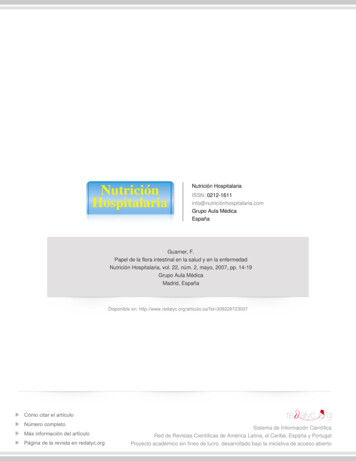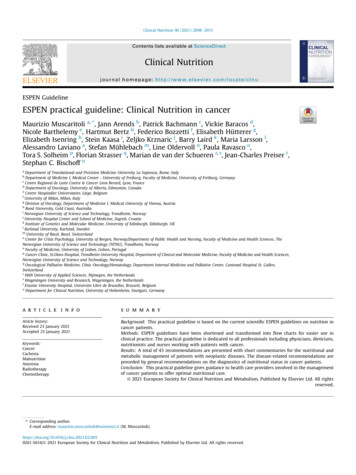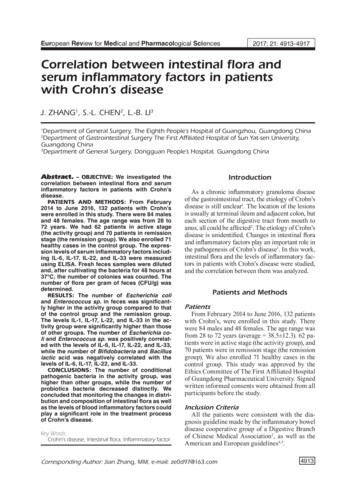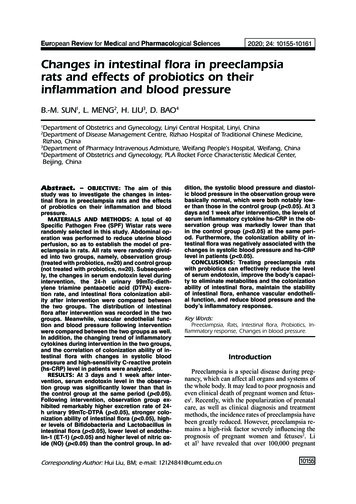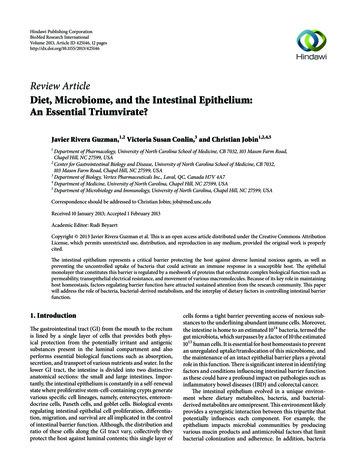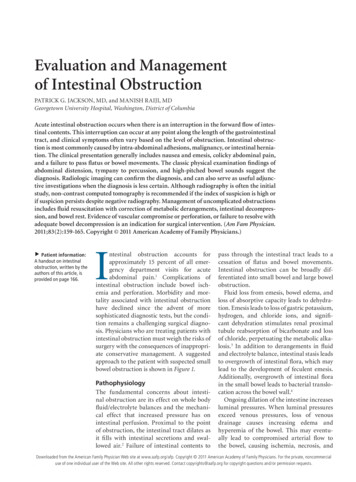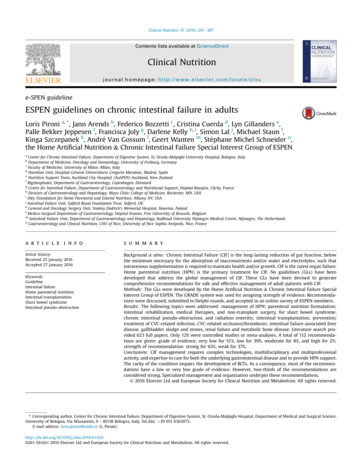
Transcription
Clinical Nutrition 35 (2016) 247e307Contents lists available at ScienceDirectClinical Nutritionjournal homepage: http://www.elsevier.com/locate/clnue-SPEN guidelineESPEN guidelines on chronic intestinal failure in adultsLoris Pironi a, *, Jann Arends b, Federico Bozzetti c, Cristina Cuerda d, Lyn Gillanders e,Palle Bekker Jeppesen f, Francisca Joly g, Darlene Kelly h, i, Simon Lal j, Michael Staun f, Van Gossum l, Geert Wanten m, Ste phane Michel Schneider n,Kinga Szczepanek k, Andrethe Home Artificial Nutrition & Chronic Intestinal Failure Special Interest Group of ESPENaCenter for Chronic Intestinal Failure, Department of Digestive System, St. Orsola-Malpighi University Hospital, Bologna, ItalyDepartment of Medicine, Oncology and Hematology, University of Freiburg, GermanyFaculty of Medicine, University of Milan, Milan, Italyd o n, Madrid, SpainNutrition Unit, Hospital General Universitario Gregorio MaraneNutrition Support Team, Auckland City Hospital, (AuSPEN) Auckland, New ZealandfRigshospitalet, Department of Gastroenterology, Copenhagen, Denmarkg pital Beaujon, Clichy, FranceCentre for Intestinal Failure, Department of Gastroenterology and Nutritional Support, HohDivision of Gastroenterology and Hepatology, Mayo Clinic College of Medicine, Rochester, MN, USAiOley Foundation for Home Parenteral and Enteral Nutrition, Albany, NY, USAjIntestinal Failure Unit, Salford Royal Foundation Trust, Salford, UKkGeneral and Oncology Surgery Unit, Stanley Dudrick's Memorial Hospital, Skawina, Polandl pital Erasme, Free University of Brussels, BelgiumMedico-Surgical Department of Gastroenterology, HomIntestinal Failure Unit, Department of Gastroenterology and Hepatology, Radboud University Nijmegen Medical Centre, Nijmegen, The NetherlandsnGastroenterology and Clinical Nutrition, CHU of Nice, University of Nice Sophia Antipolis, Nice, Francebca r t i c l e i n f os u m m a r yArticle history:Received 25 January 2016Accepted 27 January 2016Background & aims: Chronic Intestinal Failure (CIF) is the long-lasting reduction of gut function, belowthe minimum necessary for the absorption of macronutrients and/or water and electrolytes, such thatintravenous supplementation is required to maintain health and/or growth. CIF is the rarest organ failure.Home parenteral nutrition (HPN) is the primary treatment for CIF. No guidelines (GLs) have beendeveloped that address the global management of CIF. These GLs have been devised to generatecomprehensive recommendations for safe and effective management of adult patients with CIF.Methods: The GLs were developed by the Home Artificial Nutrition & Chronic Intestinal Failure SpecialInterest Group of ESPEN. The GRADE system was used for assigning strength of evidence. Recommendations were discussed, submitted to Delphi rounds, and accepted in an online survey of ESPEN members.Results: The following topics were addressed: management of HPN; parenteral nutrition formulation;intestinal rehabilitation, medical therapies, and non-transplant surgery, for short bowel syndrome,chronic intestinal pseudo-obstruction, and radiation enteritis; intestinal transplantation; prevention/treatment of CVC-related infection, CVC-related occlusion/thrombosis; intestinal failure-associated liverdisease, gallbladder sludge and stones, renal failure and metabolic bone disease. Literature search provided 623 full papers. Only 12% were controlled studies or meta-analyses. A total of 112 recommendations are given: grade of evidence, very low for 51%, low for 39%, moderate for 8%, and high for 2%;strength of recommendation: strong for 63%, weak for 37%.Conclusions: CIF management requires complex technologies, multidisciplinary and multiprofessionalactivity, and expertise to care for both the underlying gastrointestinal disease and to provide HPN support.The rarity of the condition impairs the development of RCTs. As a consequence, most of the recommendations have a low or very low grade of evidence. However, two-thirds of the recommendations areconsidered strong. Specialized management and organization underpin these recommendations. 2016 Elsevier Ltd and European Society for Clinical Nutrition and Metabolism. All rights reserved.Keywords:GuidelineIntestinal failureHome parenteral nutritionIntestinal transplantationShort bowel syndromeIntestinal pseudo-obstruction* Corresponding author. Center for Chronic Intestinal Failure, Department of Digestive System, St. Orsola-Malpighi Hospital, Department of Medical and Surgical Science,University of Bologna, Via Massarenti, 9 - 40138 Bologna, Italy. Tel./fax: þ39 051 6363073.E-mail address: loris.pironi@unibo.it (L. 200261-5614/ 2016 Elsevier Ltd and European Society for Clinical Nutrition and Metabolism. All rights reserved.
248L. Pironi et al. / Clinical Nutrition 35 (2016) 247e307AbbreviationsA.S.P.E.N. American Society for Parenteral and Enteral NutritionAuSPEN Australasian Society of Parenteral and Enteral NutritionAVFarteriovenous fistulaBMDbone mineral densityCDCCenters for Disease Control and PreventionCDDScolor doppler duplex sonographyCIFchronic intestinal failureCIPOchronic intestinal pseudo-obstructionCRBSIcatheter-related bloodstream infectionCRIcatheter-related infectionCRVTcatheter-related vein thrombosisCTcomputed tomographyCTEcontrolled tissue expansionCVCcentral venous catheterDEXAdual-energy X-ray absorptiometryEFAessential fatty acidEFADessential fatty acid deficiencyELTethanol locking therapyESPEN European Society for Clinical Nutrition andMetabolismGHgrowth hormoneGLP-2glucagon-like peptide-2HAN&CIFHome Artificial Nutrition and Chronic Intestinal FailureHPENhome parenteral and enteral nutrition1. IntroductionThe European Society for Clinical Nutrition and Metabolism(ESPEN) has recently published the recommendations on the“definition and classification of intestinal failure in adults” [1],devised by its two “special interest groups” devoted to intestinalfailure (IF), “the home artificial nutrition and chronic intestinalfailure group (HAN&CIF)” and the “acute intestinal failure group”.The recommendations comprise the definition of IF, functional andpathophysiological classifications for both acute and chronic IF anda clinical classification for chronic IF (Table 1), endorsing a commonlanguage to facilitate communication and cooperation amongprofessionals in clinical practice, organization, management, andresearch.After reviewing the original definition from Fleming and Remington [2] and the proposed changes from other authors, IF wasdefined as “the reduction of gut function below the minimumnecessary for the absorption of macronutrients and/or water andelectrolytes, such that intravenous supplementation (IVS) isrequired to maintain health and/or growth”. The term “intestinalinsufficiency” (or “intestinal deficiency” for those languages where“insufficiency” and “failure” have the same meaning) was proposedto define the reduction of gut absorptive function that doesn'trequire IVS to maintain health and/or growth [1]. According to thedefinition, two criteria must be simultaneously present to diagnoseIF: a “decreased absorption of macronutrients and/or water andelectrolytes due to a loss of gut function” and the “need for IVS”.This implies that the definition of IF precludes IVS as beingconsidered synonymous with IF, and so excludes patients receivingIVS associated with normal intestinal absorptive function, such asthose with disease-related hypophagia, anorexia nervosa, impairedswallowing or dysphagia, or those who refuse otherwise effectiveenteral RIORSPICCPNPPIPUFAQoLRCTRESBSSCFAsSRSBSTEPSVChome parenteral nutritionintensive care unitintestinal failureintestinal failure-associated liver diseaseintestinal transplantationintravenous supplementationlong-chain triglyceridelongitudinal intestinal lengthening and tailoringlow molecular weight heparinmetabolic bone diseasemedium-chain triglyceridemigrating motor complexmagnetic resonance imagingoral rehydration solutionperipherally inserted central venous catheterparenteral nutritionproton-pump inhibitorspolyunsaturated fatty acidsquality of liferandomized controlled trialradiation enteritisshort bowel syndromeshort chain fatty acidssegmental reversal of the small bowelserial transverse enteroplastysuperior vena cavaThe “functional classification” was based on onset, metabolic,and expected outcome criteria, as originally proposed by Shaffer[3]: Type I e an acute, short-term and usually self-limitingcondition.This is a common feature, occurring in the perioperative settingafter abdominal surgery and/or in association with critical illnesses,where patients require IVS over a period of days or a few weeks. Type II e a prolonged acute condition, often in metabolicallyunstable patients, requiring complex multi-disciplinary care andIVS over periods of weeks or months.This is an uncommon clinical condition accompanied byseptic, metabolic and complex nutritional complications, mostoften seen in the setting of an intra-abdominal catastrophe. It isoften an acute event, occurring in a previously healthy subject(e.g. mesenteric ischaemia, volvulus, or abdominal trauma) orcomplicating intestinal surgery and necessitating massiveenterectomy and/or resulting in one or more enterocutaneousfistulae. Less frequently, it may occur following a complication oftype III chronic IF (see below), representing “acute on chronic” IF.These patients often need the facilities of an intensive care orhigh dependency unit and always need to be managed by amulti-professional specialist IF team during their stay in thehospital. Type III e a chronic condition, in metabolically stable patients,who require IVS over months or years. It may be reversible orirreversible.Chronic intestinal failure (CIF) may evolve following type IIacute IF, may be the result of progressive and devastating
L. Pironi et al. / Clinical Nutrition 35 (2016) 247e307249Table 1ESPEN recommendations: definition and classification of intestinal failure.DefinitionIntestinal failure is defined as the reduction of gut function below the minimum necessary for the absorption of macronutrients and/or water and electrolytes, such thatintravenous supplementation is required to maintain health and/or growth.The reduction of gut absorptive function that doesn't require any intravenous supplementation to maintain health and/or growth, can be considered as “intestinalinsufficiency” (or deficiency).Functional classificationOn the basis of onset, metabolic, and expected outcome criteria, IF is classified as: Type I e acute, short-term, and often self-limiting condition Type II e prolonged acute condition, often in metabolically unstable patients, requiring complex multi-disciplinary care and intravenous supplementation over periodsof weeks or months Type III e chronic condition, in metabolically stable patients, requiring intravenous supplementation over months or years. It may be reversible or irreversible.Pathophysiological classificationIF can be classified into five major pathophysiological conditions, which may originate from various gastrointestinal or systemic diseases: Short bowelIntestinal fistulaIntestinal dysmotilityMechanical obstructionExtensive small bowel mucosal diseaseClinical classification of chronic Intestinal failureOn the basis of the energy and the volume of the required intravenous supplementation, IF is categorized into 16 combinationsIV energy supplementationb(kcal/Kg body weight)Volume of IV supplementationa (mL) 1000 [1]1001e2000 [2]2001e3000 [3] 3000 [4]0 (A)1e10 (B)11e20 (C) 20 (D)A1B1C1D1A3B3C3D3A4B4C4D4abA2B2C2D2Calculated as daily mean of the total volume infused per week ¼ (volume per day of infusion number of infusions per week)/7.Calculated as daily mean the total energy infused per week ¼ (energy per day of infusion number of infusions per week)/7/Kg.gastrointestinal or systemic benign diseases, the main clinicalfeature of congenital digestive diseases, or the end stage of intraabdominal or pelvic cancer. Intravenous supplementation isrequired for a long period or for the rest of the patient's life. Suchpatients are metabolically stable and they and/or their relatives aretrained to become independent in managing IVS at home (homeparenteral nutrition, HPN).The “pathophysiological classification” of IF has identified fivemajor conditions, which may originate from various gastrointestinal or systemic diseases: short bowel, intestinal fistula, intestinaldysmotility, mechanical obstruction, and extensive small bowelmucosal disease. In the case of a short bowel, an enterocutaneousfistula, or extensive small bowel disease, the primary mechanismof IF is the malabsorption of the ingested food, due to a reductionor bypass of the absorptive mucosal surface. In the case of intestinal dysmotility or an intestinal mechanical obstruction, theprimary mechanism is the restriction of oral/enteral nutrition as aresult of feed-related exacerbation of digestive symptoms or ofepisodes of mechanical or non-mechanical intestinal obstruction.Besides these primary mechanisms, several concomitant pathophysiological mechanisms may contribute to the severity of IF inthe individual patient. These consist of increased intestinalsecretion of fluids and electrolytes in obstructed or dilated segments, intestinal loss of fluids and electrolytes with vomiting orgastric drainage, disease-related hypophagia, accelerated gastrointestinal transit time, small bowel bacterial overgrowth, andincreased metabolic demand related to concomitant sepsis andinflammation.A short bowel may occur as a result of extensive surgicalresection or of congenital diseases of the small intestine. The clinical condition associated with the remaining small bowel in continuity (even though the total small bowel length including thatbypassed may be normal) of less than 200 cm is defined as shortbowel syndrome (SBS). Depending on the anatomy of the remnantbowel, three categories of SBS are identified: end-jejunostomy withno colon in continuity, jejunocolic anastomosis with no ileo-cecalvalve and a part of the colon in continuity, and jejunoileal anastomosis with both the ileo-cecal valve and the entire colon incontinuity.Intestinal fistulas are abnormal communications between twoparts of the gastrointestinal tract, between the gut and the otherorgans (eg the bladder), or between the gastrointestinal tract andthe skin (enterocutaneous fistulas, EC). Most of the EC fistulas formin the early post-operative period after abdominal surgery, but theymay also form spontaneously secondary to underlying pathology,such as Crohn's disease or radiation enteritis. EC fistulas are amongthe most common causes of type II IF.The term intestinal dysmotility is used to indicate the presenceof disorders of the propulsion of the gut content in the absence offixed occluding lesions. Acute intestinal dysmotility is the primarypathophysiological cause of type I IF due to post-operative or acutecritical illness-associated ileus, and a frequent concomitant cause oftype II IF, due to the impaired gastrointestinal motility associatedwith systemic or intra-abdominal inflammation. Permanent intestinal dysmotility is termed chronic intestinal pseudo-obstruction(CIPO), where the modifier “pseudo” is used to underline theabsence of occluding lesions. CIPO may be congenital or acquired,due to a variety of diseases.Mechanical obstruction of the intestinal lumen results from aphysical abnormality affecting the intestine, which may be intraluminal, intrinsic or extrinsic, of benign or malignant origin. It maybe an acute event encompassing a feature of type I IF. It may also bea prolonged feature, leading to type II or III IF, as in patients withextensive adhesions (“frozen abdomen”), or in those with peritoneal carcinomatosis associated with late-stage intra-abdominalmalignancy.
250L. Pironi et al. / Clinical Nutrition 35 (2016) 247e307Extensive small bowel mucosal disease indicates a conditioncharacterized by an intact or almost intact, although inefficient,mucosal surface, that may be of congenital or acquired origin.The “clinical classification” of CIF is aimed to facilitate communication and cooperation among professionals through a moreobjective categorization of patients and is to be used in clinicalpractice, management/administrative organization, epidemiological surveys and clinical research. It has been devised on the basis ofthe requirements for energy and the volume of the intravenoussupplementation. Sixteen categories were defined. The clinicalclassification was not intended to be a “severity classification ofCIF”. The panel highlighted that classifications carry no implications for the level of optimization of care required by the patients,which must be the same for all the patients regardless of theirclassification.2. Chronic intestinal failureChronic intestinal failure may be the consequences of severegastrointestinal or systemic benign diseases, or the end stage ofintra-abdominal or pelvic cancer. Treatment with HPN for CIF dueto end-stage malignant disease is controversial. In Europe, HPNpatients with cancer greatly differ among countries, varying from8% to 60% of the total population on HPN. This wide range may bedue to different medical and social attitudes toward palliative care.Overall, the scientific society guidelines have not recommendedHPN for patients with a short life expectancy due to malignancy(generally considered inappropriate if this is less than 2e3 months)[4]. Due to the controversial aspects of managing CIF in patientswith cancer, the present GLs are limited to “CIF due to benigndisease”, where the term benign means the absence of end-stagemalignant disease.CIF is the rarest organ failure. In Europe, the prevalence of HPNfor CIF due to benign disease has been estimated to range from 5 to20 cases per million population. CIF due to benign disease has beenincluded in the 2013 Orphanet list of rare diseases.Table 2 shows the mechanisms of CIF and the underlyingdisease from which they originated as reported by a Europeancross-sectional survey on patients on HPN for CIF due to benigndisease [5]. SBS was the main mechanism, accounting for about75% and 50% of cases in adults and children, respectively. Intestinal dysmotility was present in about 20% of both age categories.Extensive mucosal disease accounted for about 5% in adults and25% in children, the latter mainly due to congenital mucosaldisease. EC fistulas represented the cause of CIF in a few cases inadults.Reversibility of CIF and weaning from HPN after 1e2 years mayoccur in 20%e50% of patients, depending on the characteristics ofthe CIF. In patients with SBS, CIF may be reversible because of theintestinal adaptation process and/or intestinal rehabilitation programs based on medical and surgical treatments [6]. The probability of weaning off HPN has been reported to be about 50% inadults and up to 73% in children and is more likely to occur in SBSwith partial or total colon in continuity. Complete weaning off HPNin patients with SBS is relatively unlikely ( 10%) to occur after 2e3years have elapsed since the most recent intestinal resection. Inpatients with CIPO, the reversibility of CIF is lower than that reported in SBS, having been reported in 25e50% in adults and25e38% in children. Intestinal rehabilitation and weaning fromHPN in CIF due to EC fistulas depends on the possibility of performing a reconstructive surgery to recover bowel continuity andintestinal absorptive surface. Reversibility of CIF due to extensivemucosal disease rarely occurs.Patients with CIF due to benign disease have a high probabilityof long-term survival on HPN (about 80% in adults and 90% inTable 2Pathophysiology and underlying diseases of patients on long-term home parenteralnutrition for chronic intestinal failure due to benign disease (no cancer) (adaptedfrom 5).Short bowel syndrome (No. %) Mesenteric ischemia Crohn's disease Radiation enteritis Surgical complications Familial polyposis Volvulus Intestinal malformation Necrotizing enterocolitis OthersMotility disorder CIPO primary Radiation enteritis Scleroderma Hirschprung's disease OthersExtensive parenchymal disease Coeliac Immunodeficiency Crohn's disease Lymphangectasia Radiation enteritis Tufting enteropathy Autoimmune enteropathy Intractable diarrhea Microvillus atrophy OthersIntestinal fistulas Surgical complication Crohn's disease OthersAdults (n. 688)Children (n. 166)514 (74.7%)35.8%29.0%9.7%7.8%4.1%2.3%87 (52.4%)13.6%124 (18.0%)56.4%16.1%5.6%1.6%20.1%35 (5.1%)17.1%14.3%14.3%11.4%9.0%5.7%5.7%2.9%20.0%15 (2.2%)60.0%26.6%13.3%25.3%48.3%14.9%11.5%38 (22.9%)71.0%15.7%13.1%41 en at 5 years) [6]. Overall, about two-thirds of patients mayhave partial or total social and working rehabilitation as well as agood family life [7]. On the other hand, CIF may be associated withlife-threatening complications and the condition itself may behighly disabling and impair quality of life (QoL) [7]. Treatment ofCIF is based on complex technologies and requires multidisciplinary and multiprofessional activity and expertise. The outcomeof patients with benign CIF, in terms of reversibility, treatmentrelated morbidity and mortality, and survival probability isstrongly dependent on care and support from an expert specialistteam. Patients with irreversible CIF are destined to need life-longHPN or intestinal transplantation (ITx). On the basis of data onsafety and efficacy, HPN is considered the primary treatment forCIF, whereas ITx is reserved for those patients at risk of deathbecause of life-threatening complications related to HPN or to theunderlying gastrointestinal disease [6].ESPEN and other scientific societies have devised guidelines(GLs) for HPN [4,8e12] and central venous catheter (CVC) management [13], as well as for SBS [14,15]. No GLs have been developed to globally address management of CIF. The aim of the presentGL is to generate comprehensive recommendations for safe andeffective management of adult patients with CIF due to benigndisease.3. MethodsThe working group included gastroenterologists, surgeons, endocrinologists, anesthesiologists, and dietitians with long-termexpertise in IF and HPN. The GLs were developed according to theESPEN method [16]. All working group members are authors of thisguideline document. The experts followed the GRADE method,which is based on determinations of grade of evidence (GOE) and
L. Pironi et al. / Clinical Nutrition 35 (2016) 247e307strength of recommendation; the methodology is described elsewhere [17,18].In February 2014, the topics to be included in the GLs and thequestions for the recommendations within each topic weredefined. The GLs were devised between March 2014 and July 2015,through email exchanges, a two-day live meeting held in Nice,France, in February 2015, followed by three Delphi rounds [19].A systematic literature search was conducted in PubMed. Anypertinent publication retrieved from the references of the selectedpapers as well as chapters from specialized books were alsoconsidered. The GOE was determined by a number of factors,starting with the number and type of research studies [17]. Gradingfrom High to Very Low was used to rate the quality of the underlying evidence and the level of certainty for effect (Table 3) [18].Highest quality evidence resulted from consistent results or metaanalysis of multiple randomized controlled trials, with the nexthighest level defined by at least one well-designed randomizedcontrolled trial. Moderate and low-level evidence came fromcontrolled trials that were not randomized, from cohort- or casecontrolled studies, or from multiple time-series trials. Very lowlevel evidence was from expert clinical experience or fromdescriptive studies. The grade was then decreased if there werelimitations to study quality, inconsistencies in findings, impreciseor sparse data, or high likelihood of reporting bias. The grade wasincreased if there was high consistency of findings or strong evidence of association (Table 3).The strength of recommendation was based on a consensusdiscussion, which included expression and deliberation of expertopinions, risk-benefit ratio of recommendation, costs, and a reviewof supportive evidence, followed by Delphi rounds and votes untilagreement was reached (Table 4).Literature search provided 623 full papers: meta-analysis 16,randomized controlled trials 58, comparative studies 44, prospective studies 30, case-control studies 6, observational studies 243,scientific society GLs 33 or position papers 2, reviews 113, expertopinion 66, animal studies 12. The low percentage of controlledstudies may be considered to be a direct consequence of the rarityof CIF, a factor that impairs the feasibility of well-designedinvestigations.A total of 112 recommendations were devised. On July 29th2015, the final list of recommendations was sent to all 2755 ESPENmembers with an e-mail address on file to ask for approval/disapproval or no opinion of every statement, and in case ofdisapproval to provide justification and any supporting paper. Fiftyfour members completed the survey. The rates of approval are reported in Table 5.A rate of approval equal or greater than 80% was reported in82.1% of the recommendations. For only 4 questions the approvalrate was lower that 70%, this was related to a high percentage ofresponders who expressed no opinion. The final disapproval rateranged from 0 to 11%. In no cases was the disapproval supported bya literature reference. Thus, only minor changes, not requiringfurther submission to ESPEN members, were made to a few statements according to the received comments.251Table 4Strength of recommendation.Strength of recommendationStrongWeakWe recommend/do not recommendWe suggest/do not suggest4. RecommendationsTable 6 lists the statements along with their GOE and strengthof recommendation. The GOE is very low for 51% of the recommendations, low for 39%, moderate for 8%, and high for only 2%.The strength of the recommendation is strong for 63% and weakfor 37% of them. Notwithstanding the high percentage of recommendations with a very low or low grade of evidence, due to thelack of RCTs, the strength of the recommendations was consideredstrong for two-thirds of them. This highlights how CIF management requires complex technologies and multidisciplinary andmultiprofessional activity and expertise dedicated to the care ofboth the underlying gastrointestinal condition and the HPNsupport.4.1. Management of home parenteral nutrition for benign chronicintestinal failure1. We recommend that the aims of an HPN programme includeprovision of evidence-based therapy, prevention ofHPNerelated complications such as catheter-related infections and metabolic complications and ensure quality oflife is maximized. (Grade of evidence: very low)2. We recommend regular audit of therapy and outcomesagainst standards to ensure safety and efficacy of an HPNprogramme. (Grade of evidence: very low)The aim of a safe and effective HPN programme for CIF has beenconsidered in national strategic planning of IF services [20]. Theprinciples used in the planning for an Intestinal Failure and HPNservice in England included: Provision of consistent and high care standards throughout thecountry Foster equity of access for IF/HPN patients throughout thecountry Allow access for patients to high quality and clinically safe services as close to their homes as possible Be patient centered and use resources appropriately andeffectively Reflect on models of care and ensure that the framework ofservices remains relevant to patients Develop and sustain mechanisms that demonstrate value formoney in the provision of HPN and IF services through audit andoutcome reportingTo identify the ultimate aim of the HPN therapy, a set of expected and desirable results is needed for HPN patients [21]. A set ofoutcome indicators has been developed that allows goals ofTable 3Grades of evidence [18].LevelDefinitions of evidenceHighModerateLowVery lowFurther research is unlikely to change our confidence in the estimate of effect.Further research is likely to have an important impact on our confidence in the estimate of effect and may change the estimate.Further research is very likely to have an important impact on our confidence in the estimate of effect and is likely to change the estimate.Any estimate of effect is very uncertain.
252L. Pironi et al. / Clinical Nutrition 35 (2016) 247e307Table 5Approval, disapproval, and no opinion rates by 54 ESPEN members who evaluatedthe 112 recommendations.Recommendationsn. (% of total)Approval (%ofresponders)Disapproval (%of responders)No opinion (%ofresponders)43 (38.4)40 (43.7)16 (14.3)3 (2.7)1 e1813e2326e3348treatment to be defined. The indicators were developed by anexpert panel of health care clinicians in Europe and were subdivided into patient outcomes and therapy outcomes [22]. The topscoring outcome indicator for clinicians was prevention of catheterrelated infections.Patient priorities and concerns were sought in a survey of HPNpatients with underlying benign disease in nine centres over eightcountries [23]. This cohort identified incidence of catheter-relatedinfections, survival and quality of life (QoL) as the most importantindicators of their care.The aims of a safe and effective HPN programme must therefore focus on therapy outcomes. It is important that catheterrelated infections (CRI) are diagnosed early and treated effectively to minimize the associated risks [24,25]. All HPN-relatedcomplications including catheter obstruction, central venousthrombosis, liver disease, and osteoporosis, should be recognizedas part of regular surveillance and treated early within an experienced multidisciplinary team to prevent later irreversiblecomplications.To measure and provide
gastric drainage, disease-related hypophagia, accelerated gastro-intestinal transit time, small bowel bacterial overgrowth, and increased metabolic demand related to concomitant sepsis and inflammation. A short bowel may occur as a result of extensive surgical resection or of congenital diseases of the small intestine. The clin-
